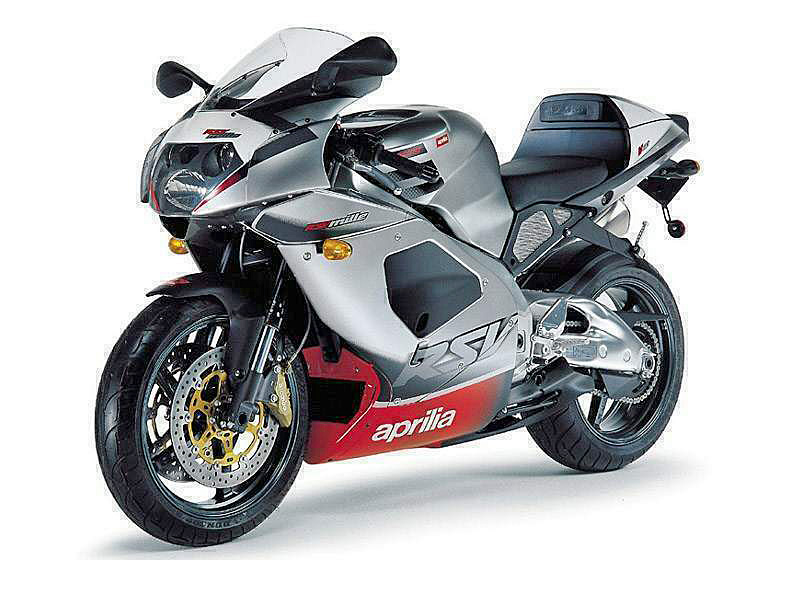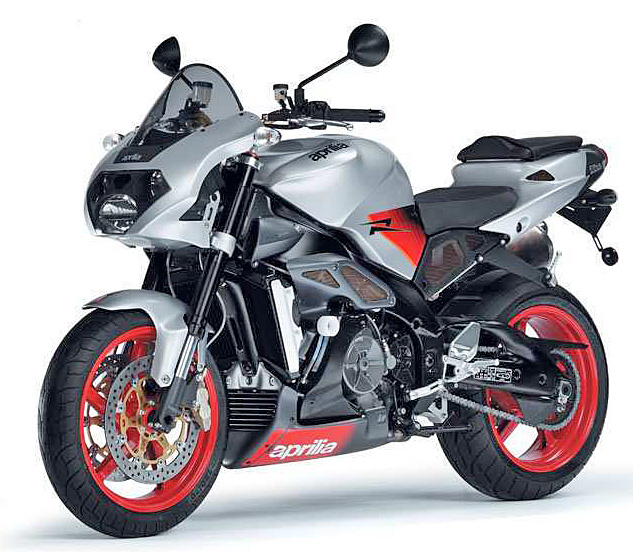Motorcycle Investor mag
Subscribe to our free email news

Profile: Aprilia RSV Mille & RSV 1000 R

by Guy ‘Guido’ Allen, Jan 2021
Twin Tornado
Aprilia’s RSV series, and its first litre-class pukka sports bikes, seemed to come out of nowhere
It’s hard to imagine now, but just 23-ish years ago if you’d walked down any motorcycle retail strip in this country, looking to buy a big Aprilia, you couldn’t. Didn’t exist.
You just might have been offered a Climber 240 – a trials bike – from 1989, but that’s it. By the mid nineties you could add a two-stroke sports bike in the form of the RS125 and RS250, or a quirky four-stroke single in the shape of the Phillipe Starck-designed Moto 6.5.
Though the company has a reasonably long motorcycle history, it’s mostly been to do with smaller machinery, and its rise in performance bike circles has been meteoric
That was done off the back of an aggressive racing campaign, with names such as Rossi, Biaggi and Corser among its alumni. In 1998 (really 1999 by the time it hit the market) the company launched with two new road bikes: the RSV Mille sports twin and RST Futura sports tourer. The Mille formed the basis of its first tilt at the world superbike title in 1999.
In some respects this launch had a lot in common with BMW’s much later S 1000 RR, in that the company – despite having never before produced a bike in this category – hit the proverbial nail on the head from day one.
At the heart of the monster was a 60 degree fuel-injected and liquid-cooled V-twin produced by Rotax, The Austrian engine maker already had a solid reputation and its partnership with Aprilia did much to raise it further.
That powerplant claimed a respectable 128 horses (93kW) at the crank and it seemed legitimate, given subsequent dyno tests.
Really, this was a cracker of an engine, with good throttle response and punchy performance across the range.
Holding it all together was the obligatory twin-spar aluminium frame, in this case a nicely-polished item, while the big banana-shape swingarm was a work of art.
Overall the styling was a little quirky, lacking the deceptively simple elegance of Ducati’s rival 916/996 series. However it had a certain charm of its own. Without doubt the stand-out feature was the triangular three-lamp headlight set.
The bike was substantially bigger than the Ducati, too – certainly taller – which may not have been ideal in the world of sports bikes, but made it a much more user-friendly ride for bigger people.
Standard spec was a Showa upside-down front fork, matched to a Sachs rear shock. Braking was a four-spotter set of Brembos up front and a twin-piston rear.
In many respects, this was a very conventional motorcycle for its day, certainly there were no shocking technical innovations on board. However it was well thought-out and a seriously quick bit of gear.
Handling was sharp, braking strong and predictable and in performance terms this was a formidable competitor to Ducati. Its pricing undercut Ducati at $25,700 (plus ORC) compared to $29,000 for a 996 Strada in 1999. A Fireblade that year cost $16,000, so you were stumping up a substantial premium for the Italian machinery.

Of course it wouldn’t be an Italian sports bike if there weren’t a few special editions. The most desirable is the RSV 1000 Mille SP of 1998 (above), of which only 150 were made. This was a superbike homologation special and it’s uncertain whether any made it to Australia. In any case, in time they will have serious collectible status.
Next was the RSV 1000 Mille R, sold here in 2000 for $29,400. It included upgraded brakes – Brembo Goldline – plus Ohlins suspension front and rear. There were some tuning alterations which added around five to 10 horses, though these appeared to make the engine feel a little more peaky.
There were some running changes in 2000, including some revision of the oil and damping rates for the rear shock (which could get tired and emotional with hard riding) and the transfer of the R model tuning map to the base model.
The series underwent a freshen-up from 2001, which involved a claimed 199 alterations. That went from fiddling with switchgear location, through to more substantial changes such as subtly altering the location of the swingarm pivot. Most noticeable to a rider was the fuel tank was narrowed a little at the rear (at the loss of two litres of fuel). Brakes and suspension had also been freshened up, while the clutch had been upgraded.
Visually, this second series looked very similar to the first, though the graphics had been played with. All up it was a regarded as a better-sorted ride. Really, it was a case of incremental rather than radical improvement and no reason for the owners of earlier models to feel cheated.

Move on up to 2004 and we got a complete make-over of the RSV series, in the form of the second-generation RSV 1000 R (Factory version shown above).
The styling had become more coherent, while the bike had been physically shrunk. Both the frame and swingarm had been updated and really looked like works of art. This was a seriously attractive motorcycle and visually less quirky than its predecessor.
While still a 60-degree V-twin running balancers, the engine had been through a revision and now claimed a whopping 143 horses (105kW).
Though the RSV had changed shape substantially, the claimed dry weight remained at a competitive 189kg.
Front suspension had been upgraded to Ohlins, while the rear was a Sachs unit.
Despite the upgrades, the pricing had dropped, to $25,500 plus ORC. This reflected both changes in the tax regime (GST had now been in place for a while) and a shift in the value of the local dollar.
Meanwhile Aprilia continued with a run of specials based on the RSV, including the RSV 1000 R Factory. Costing an eye-watering $33,500, it included a host of niceties, such as more sophisticated suspension (Ohlins Racing at both ends), different wheels and carbon fibre body panels.
If you had to have something really exclusive, there was a Nera model, which made extensive use of titanium and magnesium to drop the overall weight by around 20kg. Only 200 were made and it’s unclear how many (if any) made it here.
In today’s market, the first-generation bikes in particular offer great value for money. R versions are generally priced in the low to mid-teens, while a good Mille can be found for $6000-7000 range. That’s a lot of thrills for your buck. They’re mechanically reliable (oil pressure sensors could sometimes pop) and should last well so long as they’ve been serviced. Clutches can benefit from an upgrade, while the original rear shocks respond well to a rebuild.
As for the 2004-on generation, you can get a very good one for mid to low teens. Weirdly, I’m not seeing much of a price difference between the standard version and the Factory.
What’s the pick of them? In an ideal world, you’d be looking for one of the bikes out of that first batch of 150 homologation specials from 1998. However any of the models from the first and second generations are worth a look. If you're patient, you still see the odd good one pop up on the market for not a whole lot of money. On a smile per dollar basis, they're damn near unbeatable.
These bikes aren’t really on the collector radar at the moment, but probably deserve to get there...one day.
***

Captain Ratbag
In 2004 we saw the RSV platform used for a naked bike for the first time – the Tuono. Though a surprisingly ugly bit of kit (sorry Tuono owners, but someone had to say it…), it quickly developed a reputation for being the most entertaining sports bike on the planet. If you owned one, you could wave goodbye to your licence.
***
See our Features page for more Aprilia stories
***
Good
Lots of bike for the money
Fast
Sharp
Not so good
Potentially a limited resale market
SPECS:
Aprilia RSV Mille
ENGINE:
TYPE: Liquid-cooled, four-stroke, four valve, 60 degree V-twin
CAPACITY: 998cc
BORE & STROKE: 97 x 67.5mm
COMPRESSION RATIO: 11.4:1
FUEL SYSTEM: injection
TRANSMISSION:
TYPE: Six-speed, constant-mesh,
FINAL DRIVE: Chain
CHASSIS & RUNNING GEAR:
FRAME TYPE: Twin spar aluminium
FRONT SUSPENSION: 43mm Showa USD fork, full adjustment
REAR SUSPENSION: Sachs single shock, full adjustment
FRONT BRAKE: 320mm discs with four-piston Brembo calipers
REAR BRAKE: 220mm disc with twin-piston caliper
DIMENSIONS & CAPACITIES:
DRY WEIGHT: 189kg
SEAT HEIGHT: 825mm
WHEELBASE: 1418mm
FUEL CAPACITY: 20lt
WHEELS & TYRES:
FRONT: Cast alloy 120/70 ZR17
REAR: Cast alloy 190/50 ZR17
PERFORMANCE:
POWER: 93kW @95000rpm
TORQUE: 103Nm 7250rpm
OTHER STUFF:
PRICE WHEN NEW: $25,700 + ORC
-------------------------------------------------
Produced by AllMoto abn 61 400 694 722
Privacy: we do not collect cookies or any other data.

Archives
Contact




